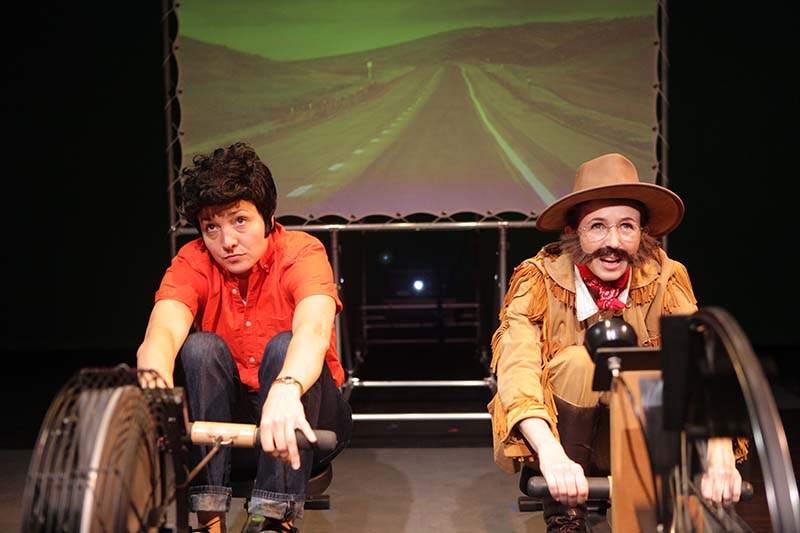Ann Arbor Area Artists at ArtPrize 8
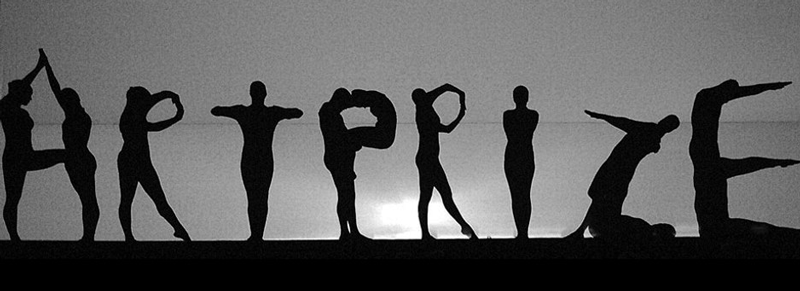
It's official – ArtPrize 8, the "radically open international art competition" in Grand Rapids, Michigan, now boasts the largest attendance to an art event on planet Earth. The 19-day event is now over for this year, the votes have been tallied and the 2 Grand Prize Winners (as well as the winners of the Category Prizes) have been announced.
Visitor numbers for this year have yet to be tallied, but from a mere 200,000 visitors in 2009, last year's event drew over 400,000 visitors from all 50 states and 47 countries. Clearly, ArtPrize has been and continues to be a wildly successful and popular art event that has put Grand Rapids on the cultural map.
Artist participation has fallen slightly from a high of 1,713 in 2010 to this year's 1,453. In a tacit admission that the event may be more of an unmixed blessing for the town than it is for the artists, additional prize money has been added to the two whopping $200,000 Grand Prizes in the form of 8 smaller $12,500 prizes in 2-dimensional, 3-dimensional, time-based, and installation categories (both voted by the public and juried)–plus a juried prize for best curated venue. Grants totaling $280,000 have also been awarded to artists, curators and venues for fabricating and installing site-specific artworks and exhibits.
Five entries from the Ann Arbor/Ypsi area were on view in Grand Rapids this year, and they are representative of the diverse backgrounds and professional experience of ArtPrize artists overall:

One Ann Arbor/Ypsi entry, Invasive Species by Shiny Seed, managed to make it into the prestigious final round of 20 for the $200,000 Public Choice Award, although the top prize ultimately went to Wounded Warrior Dogs by James Mellick of Milford Center, Ohio. (The Juried Grand Prize went to The Bureau of Personal Belonging by Stacey Kirby of Durham, North Carolina.)
Invasive Species, a giant aluminum-wrapped and LED-festooned tree, is a collaborative effort by software/electrical engineer and sculptor Gene Foulk and Casey Dixon, artist and shop manager of Maker Works in Ann Arbor. Invasive Species displays in abundance the qualities that can seize and hold the attention of the ArtPrize public and win their votes. It is figurative, centrally located, monumental in scale. It also demonstrates the technical mastery of the artists, is meticulously crafted and expresses commonly shared values in its environmental theme.

ArtPrize 8 is Ann Arbor glass artist Janet Kelman’s first experience with the event. She has been creating works of art in glass since she fell in love with the material while studying chemistry in college. Her wall-hung relief/assemblage Oracle was installed on the second floor of the Gerald R. Ford Presidential Museum.
Kelman is drawn to water and images of water, and her latest work is an exploration of that fascination. Oracle is one of a series on this theme. It is deceptively simple in form but complex in execution. Composed of 16 separate layers of fused glass displayed at varying distances from the wall, the panels overlap and interrelate in color and shape. She describes her process, saying, "I create small glass pieces using threads of glass, enameled images, crushed glass, whatever else I can dream up, and assemble them in layers on a kiln shelf. The finished fused glass always provides surprises, its constant allure."
Other work by Janet Kelman can be seen at WSG Gallery in Ann Arbor and Vale Craft Gallery in Chicago.
Megan Foldenauer, whose time-based drawing and video How to Draw the Human Eye was on view at the Women's City Club, has lived and worked as an artist in Ypsilanti for 11 years. Her virtuosic pencil drawings of a wide variety of single human eyes arranged in a grid around a small video screen make excellent use of her background in anatomy and medical illustration. She claims she has always known how to draw: "I'm one of those 'all of the sudden I could draw' types. A gift, a calling, a life’s purpose, whatever you wanna call it – I didn’t have to work-work-work to be able to draw… it’s just something I can always remember doing."

A freestanding diptych by J. Daniel Strong was installed in a corner park a bit off the beaten path during ArtPrize. Strong is an Ann Arbor muralist who usually works on commission. The imagery on the front of Pallet is based on Roman paintings in Pompeii, with an array of quotes on the back that refer to humans and their interaction with nature over time.

I was pleased, and a little surprised, to see an artwork by Peter Warburton prominently displayed on the main floor of the Gerald R. Ford Presidential Museum. I have seen Warburton's "paintings" from duct tape from time to time in coffee shops around Ann Arbor and Dexter, and have always been charmed by them. A self-taught artist, he has often taken works by Vincent Van Gogh as inspiration for his pictures because he feels a spiritual kinship with the troubled French Impressionist. In Sunset, Monmartre, 1896, he evokes the jumpy stippling of Van Gogh's brushwork; the sun shining over the windmill in the picture mimics a giant eye glaring at the landscape below.
The participating artists’ opinions of ArtPrize experience are, finally, as varied as the individuals themselves, from an enthusiastic “pretty awesome” to a less positive “I’ll never do that again” and everything in between. The key to evaluation of the ArtPrize experience though, is in the management of expectations. With only 11 prizes to divide among over 14,00 entries, artists must weigh whether exposure of their work, engagement with the public and a line in their resume justifies the considerable expenditure of money and time required. What isn’t in doubt is the genuinely positive--and even transformative--effect ArtPrize has had over the last eight years for the city of Grand Rapids and its citizens.
K.A. Letts is an artist and art blogger. She has shown her work regionally and nationally and in 2015 won the Toledo Federation of Art Societies Purchase Award while participating in the TAAE95 Exhibit at the Toledo Museum of Art. You can find more of her work at RustbeltArts.com.
ArtPrize is an annual event in Grand Rapids, MI. For more information about ArtPrize go to artprize.org.
Overview: Pop-X 2016

It may sound like lofty praise, but it’s becoming readily apparent that POP•X is one of the most important events on the contemporary Ann Arbor visual arts calendar. It’s a curious blend of some of our most talented arts groups and individual artists tacitly stepping out of their comfort zone.
The polish and professionalism on display in the installation site was POP•X 2016’s conventional strength—and its non-conformity was the fact that the event took place at all. While this seeming contradiction may be paradoxical to some, it follows seamlessly (perhaps even providentially) from a trajectory that fits the mood of our time.
For the fact is: POP•X fills a gap in our local visual arts that’s been all-too-lacking for some time on our arts calendar. Tucked nicely in downtown’s Liberty Plaza, the installation site was as tidy and manageable as an arts event could be in contrast to the overwhelming behemoth that annually invades Ann Arbor over the course of a week in July. That massive congregation may be ostensibly devoted to the arts, but it’s not really about art. Rather it’s a merchandizing juggernaut that allows the entire community to celebrate the idea of art.
By contrast, POP•X 2016 is a different thing altogether. It partakes of the slightly off-kilter vibe of the mid-20th century “happening.” Granted, it’s far tamer than the Allan Kaprow inspired performance art which sought to perplex as much as it meant to elucidate. But then again, everything slows down as it matures.
There’s instead a touch of the provocateur in POP•X 2016. And the art is of sufficient quality as to gently mask this tension. Instead, as would have been noted by the countercultural Fluxus group of this same mid-20th century period, it’s the sheer concreteness of POP•X that democratizes the activity. There’s no artificial boundary to the event (outside of its physical boundary) because the only border to POP•X 2016 is territorial and this is a logistical distinction.
Whether referencing Kaprow’s performance art or Fluxus’ abstraction, it was one of Neo-Dada's conceits that art be taken off the wall—Pop Art, Environmental Art, Conceptual Art, Optical Art, and other likeminded art forms of this stripe—sought to reinterpret the concept of art altogether. Yet one of the aesthetic ironies of Modernism was that even these kinds of art were still typically found confined to the gallery setting with all the expectations of such pretensions.
Let’s just suffice to say POP•X 2016 bursts though the aesthetic fourth wall of the gallery mentality by gleefully setting up shop outdoors and letting the setting itself serve its basis. But the conventionality of the “art” market has also restricted the possibilities of democratizing the aesthetic potential.
By contrast, POP•X effectively uses the conventions of art to work in an allied configuration that expands these possibilities. Indeed, it’s likely (on the presumption that Ann Arbor is wise enough to continue in this vein) that the possibilities of POP•X have not really yet been broached.
If only for the reasons mentioned above: There’s a homey feel to the POP•X 2016 spirit that’s channeled through the professionalism of the artists and art groups on display. The impulse is clearly there: For example, Lisa Waud’s incarnation of her Detroit-based Flower House utilized her installation to craft a display of nature that threatened to burst from its confine. And although it was based on the limitation of its video monitors, there is a remarkable amount of possible expansion in Donald Harrison and Martin Thoburn’s invigorating four-channel installation roaming Ann Arbor from each direction via its Liberty Plaza starting point.
Effectively—and, again, presuming our arts community is wise enough to build on this remarkably dexterous POP•X format—we still haven’t seen what POP•X 2016 can really be. The possibilities are there; just as the evolution of the village lies in the flexibility of the pavilion format. And this is the most exciting—as well as most important—element of the format.
As is evident from other places and events, contemporary art is clearly reconsidering itself at this time through the adventurousness of its practitioners. It was most evident in the mid-to-late 20th century through the reincarnation of ceramics, fabrics, and functional design.
This is the fundamental and continual challenge of all aesthetics. And POP•X is on the vanguard of this most recent artful transition. So the only real question then is what this change can be?
Because if POP•X 2106 is any indication, we don’t really know yet. For it’ll be the task of our local artists and arts groups as well as visionaries like the Ann Arbor Art Center’s Omari Rush to nurture the concept through its possible growth.
Rather than hope that we see a POP•X again—think in terms of how we see it again. For this is the test of the visual arts.
John Carlos Cantú has written on our community's visual arts in a number of different periodicals.
POP•X is an annual ten-day festival presented by the Ann Arbor Art Center. POP•X 2016 was Thursday, September 22 through Saturday October 1, 2016 from noon to 8pm at Liberty Plaza Park, 255 East Liberty St, Ann Arbor. To learn more visit popxannarbor.com or the POP•X Facebook event page. POP•X is free and open to the public.
Review: We Came, We Drank, We Polka Danced: It’s Oktoberfest Time in the City!

Even before I changed careers and became a teacher, fall has always felt like the “new year” to me. The weather changes, the trees look different and pretty, people buy new school clothes and there’s just a general feeling of settling into a new routine. And it's Oktoberfest time!
Every year, Arbor Brewing Company closes down Washington Street and throws the party of all parties with brats, German potato salad, an Oom-pah Band, and of course, plenty of beer. Thirsty patrons, some decked out in lederhosen and dirndls, enjoyed the four beers on tap this year: Euchre Pilsner, Olde #22 German Alt, Festbier, and the Oktoberfest marzen.
The first Oktoberfest beer that I ever had was from the late Leopold Brothers in Ann Arbor. The deliciousness of their beer prompted me to investigate more. A classic Oktoberfest should be malty but not overly sweet; have a light to moderate toasty malt aroma; low to moderate hop bitterness; and an overall smooth, clean, and rich malty character. Arbor’s Oktoberfest fit the bill perfectly. It was the choice of Events and Marketing Manager Elizabeth Cain-Toth. “It’s my personal favorite, perfectly balanced with spicy hops and sweet malts.”
Festbier, the newest beer, hit all the right notes. Made with paler grains and more hops than the marzen, this lager was crisp and clean all the way through. In addition to the two other beers, Oktoberfesters could also enjoy red wine or hot, spiced cider. Immigrant Sons brought the music, playing German drinking songs, top 40 hits, and polkas.
As a special treat this year, two liters of beer were available for the taking if one bought an Oktoberfest “boot”. Beer boots began as a military hazing ritual, and they used actual boots to drink from! The tradition came to America along with the GIs returning from World War II. The boots are now made from plastic or glass, but the drinking remains the same. There are some rules to follow when drinking from the boot, including that one must pass the boot clockwise, one must drink again if one is splashed, and whomever lets the boot touch the table buys the next boot. (None of these rules were abided by me, because I got the brilliant idea of scooping beer out like it was a punchbowl. That sort of worked).
If you missed it, you can still enjoy the beers on tap at Arbor Brewing Company. Get a brat and create your own, private Oktoberfest -- but without the lederhosen, unless you are reallllly into it. Prost!
Patti Smith is a special education teacher who lives in Ann Arbor with her husband and cats. She is the author of two books about Ann Arbor, the most recent is a history of the People’s Food Co-op. Visit her at PattiFSmith.com or @TeacherPatti on Twitter.
Review: The Purple Rose's Morning After Grace Is a Hilarious and Sensitive Comic Drama

Growing old can be hell but it can also be hilarious as proven by the Purple Rose Theatre Company’s World Premiere presentation of playwright Carey Crim’s Morning After Grace.
Crim’s meditation on aging, marriage and sexual frustration is in the superb hands of director Guy Sanville. A three-actor cast handles the unforced and sparkling humor with the precision of a well-disciplined string quartet while also letting it all out when the humor turns to a cathartic sadness.
The scene is a wealthy retirement community on Amelia Island, Florida. An older but still handsome man stumbles from his bedroom into his living room with all the evidence of a head-splitting hangover. He plops on a couch with a look of bewildered exhaustion and falls into a light sleep. Suddenly, a head pops out from a tangled comforter. A woman’s face peeks out and a giddy, happy grin spreads across her face.
In this small opening we immediately understand the dynamic that will play out in Crim’s play. These two characters were strangers to each other just a day before. They’ve had a night at the man’s condominium. Their very different personalities will delight, challenge and comfort each other over a momentous morning.
The title is a pun. Grace refers both to the religious meaning of divine favor but it also refers to the man’s now-deceased wife, whose funeral is the catalyst for what ensues. In this production, it also could refer to the grace and style of the three performers.
Michelle Mountain is Abigail. Her beaming entrance is a clue to Abigail’s attempts to keep a happy mood as she navigates her way through her mid-60s after a divorce. Mountain is a gifted actress. She is as adept at physical comedy, which she demonstrates with some creative costume changes, as she is with fast repartee. She has an expressive face that can light up with delight and also display deep sympathy. Her Abigail seems to have it all together as a professional grief counselor until bit by bit we learn of her insecurity. But she’s an optimist and sweet-natured, a perfect foil to the stranger she went home with.
Randolph Mantooth is Angus, Abigail’s emotional opposite. He’s a young-looking 70-year-old with some unsettled business with his late wife. But he has long been a taciturn, cynical and angry man. This comes through in some sharp barbs that Mantooth delivers with droll precision. Mantooth’s gruff demeanor has a shaggy dog quality that promises that his bark in worse than his bite, even when things get a bit rough. He seems to be getting the upper hand in his byplay with Abigail, but things take an unusual turn.
Ollie enters the scene. Ollie is another resident at the community. He’s a 66-year-old former Detroit Tiger and Grace’s friend. Played by Lynch Travis, a big man who brings big warmth to the character of Ollie, he could seem menacing, but is really gentle, big-hearted and struggling with issues of his own.
Sanville has a deft touch with comedy. He never allows his actors to overplay or get out of character for the purpose of drawing a bigger laugh. This is comedy rooted in reality. These three fine actors bounce lines off each other that are often roaringly funny but are never delivered as jokes. Crim’s comedy emerges from the characters she has created not from a standard joke book.
It would be unfair to those planning to see the production to say more about the plot, but the story has several amusing revelations that twist the perspective on what we’re seeing. As we begin to understand what has gone wrong with Angus’ marriage, comedy gives way to some agonizing self-reflection and real moments of despair. Mantooth makes these moments chillingly real.
Just as the comedy itself is rooted in the real world, Sanville and set designer Bartley H. Bauer have opted to create a stunningly realistic upscale Florida condo, complete with a state of the art kitchen, which plays a major role in the play. This works well as it makes voyeurs of the audience, giving the sense that we are really there is someone’s apartment watching these three lives entangle.
Crim has premiered five plays at the Purple Rose and has a booming career on regional and Broadway stages. This is an excellent addition to those successes. She’s a witty, subtle but also deeply sensitive playwright. She explores in the real context of this play some serious issues facing older people and she brings true compassion to the questions raised. The play should get produced at many other theaters in the future.
This is a winner for the Purple Rose, a fine play with a superb cast.
Hugh Gallagher has written theater and film reviews over a 40-year newspaper career and was most recently managing editor of the Observer & Eccentric Newspapers in suburban Detroit.
Regular performances of Morning After Grace are Thursdays-Saturdays at 8 pm, with 3 pm matinees Wednesday and Saturdays and 2 pm matinees Sundays through Dec. 17 at the Purple Rose, 137 Park St., Chelsea. For more information or to make reservations, call the Purple Rose box office at (734)433-7673 or visit them online.
Review: U-M’s Ah, Wilderness! Offers Solid but Stiff Effort in O’Neill Comedy
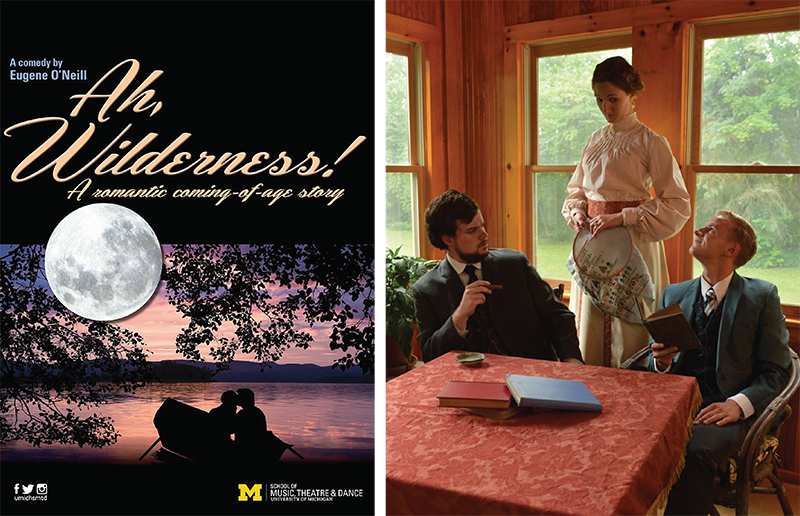
Ah, Wilderness! is an outlier among Eugene O’Neill’s plays, usually full of painful truth telling. It’s a summertime comedy, nostalgic for the youth the playwright never had. Its humor is soft and warm but it is also a quiet reflection on the limits of freedom, set appropriately on the Fourth of July.
The play offers two challenges to a university theater company. It is set in 1906, a time that O’Neill romanticizes as a period of innocence and propriety under assault, a time far removed from now. It is also a family play, in which most of the characters are younger or quite a bit older than the student actors.
The University of Michigan School of Music, Theatre and Dance cast under the direction of John Neville-Andrews tries hard to create a semblance of an early 20th century family but seems stiff, corseted in their roles and their interplay with each other. This play depends on that interplay, but in this production only a few scenes capture what O’Neill was about.
The Millers of a “large small town” in Connecticut are a solidly middle class clan. Father Nat is the owner of the local newspaper, his wife, Essie, is the dominant figure at home and a stickler for moral values. They have four children, Arthur, a Yale student; Mildred, a modern young woman; Richard, an emerging firebrand; and young Tommy, a firecracker in more ways than one.
Richard is the central character here. He’s a young man intoxicated by new, revolutionary ideas. He’s hiding his copies of Oscar Wilde, Bernard Shaw, Algernon Swinburne and Omar Khayyam. He’s also intoxicated with a girl named Muriel and trying out all he’s learned on her innocent person.
Another main character is Essie’s brother Sid. Uncle Sid is a cautionary tale, an alcoholic with a good heart and a crippling weakness. Sid is the object of Nat’s sister Lily’s affection and deep disappointment.
The Fourth is a holiday dedicated to celebrating a revolution and the ideas it helped take hold. But Richard is a classic naïf, a 16-year-old boy anxious to get on with becoming a man and ready to take that first step into naughty rebellion.
This production never settles into a comfortable give and take. The actors seem too often to be reciting and moving stiffly about. The gentle humor is often lost and the humor that is meant to be forced and awkward is never separated from all the rest. The actors seem to have trouble playing the middle aged characters authentically and fall back on stiff mannerisms of an earlier time. But there are good moments and solid effort.
Kevin Corbett gives Richard Miller the right amount of "gee whiz" enthusiasm for the swirl of ideas in his head and he has some good comic moments as he goes to the “dark side” in his encounter with a brassy lady of the night. But even he doesn’t quite capture the giddiness and fear of a boy on the cusp of manhood.
Larissa Marten has every bit the look of a strong matriarch as Essie. She’s tall with an attractive face made stern from admonishing her children. She also has a commanding voice. But her performance is stiff, missing the humor intended under what she says and posing too often. Essie is more than she seems as we see later in the play, but we get few suggestions of that early on.
Liam Loomer brings honest warmth to the role of Nat. He struggles to relax into a real middle-aged man and is forced into playing with cigars and pipes and too much joie de vivre. He does a fine bit of physical comedy in a scene with Corbett where he struggles to explain the “facts of life.” Loomer also has an uncanny resemblance to a young Orson Welles.
Oren Steiner probably has the hardest role in the play as Uncle Sid. Sid is a one-time valued newspaper reporter brought down by a weakness for alcohol. Despite his weakness, Sid is a lovable drunk, not the usual mess found in other O’Neill plays. Steiner does a good job of melding the two sides of Sid and brings some sweet interplay with his nephew Richard after Richard’s night out. But a lot of the humor that is sad/funny about Uncle Sid doesn’t come through and seems, again, stiff and labored.
Amy Aaron as the long-suffering Lily is fairly convincing but looks far too young for the part and lacks the nervousness that seems intended in a character defined as “poor spinster” forced to take shelter in her brother’s house while pining for desolate Sid.
Juliana Tassos plays the brassy prostitute with a nod to Mae West and a squawky voice. Morgan Waggoner is the ethereal Muriel. She gets the tension between desire and rectitude as the play becomes a poetic valentine.
A couple actors seem a bit more relaxed in their performances. Sarah Prendergast plays sister Mildred with a breezy good humor and no posed mannerisms. Eddie Williams as a shifty bartender is also natural as he seems to glide across the barroom.
Ah, Wilderness! was a sweet spot to which O’Neill never ventured again. His family plays in the future would be dark and brooding and even more revolutionary than Wilde, Shaw or Omar Khayyam. But even here he raised some real issues about the limits of freedom and the value of restraint when it comes in the warm embrace of a loving and upright family.
Hugh Gallagher has written theater and film reviews over a 40-year newspaper career and was most recently managing editor of the Observer & Eccentric Newspapers in suburban Detroit.
Ah, Wilderness! continues at the Arthur Miller Theatre on the North Campus of the University of Michigan at 7:30 p.m. Oct. 13, 8 p.m. Oct. 7,8,14 and 15 and 2 p.m. Oct. 9 and 16. For tickets, call (734)764-2538, go online to tickets.music.umich.edu or in person at the League Ticket Office in the Michigan League building at Fletcher and N. University.
Review: "Mr. Joy" at Theatre Nova
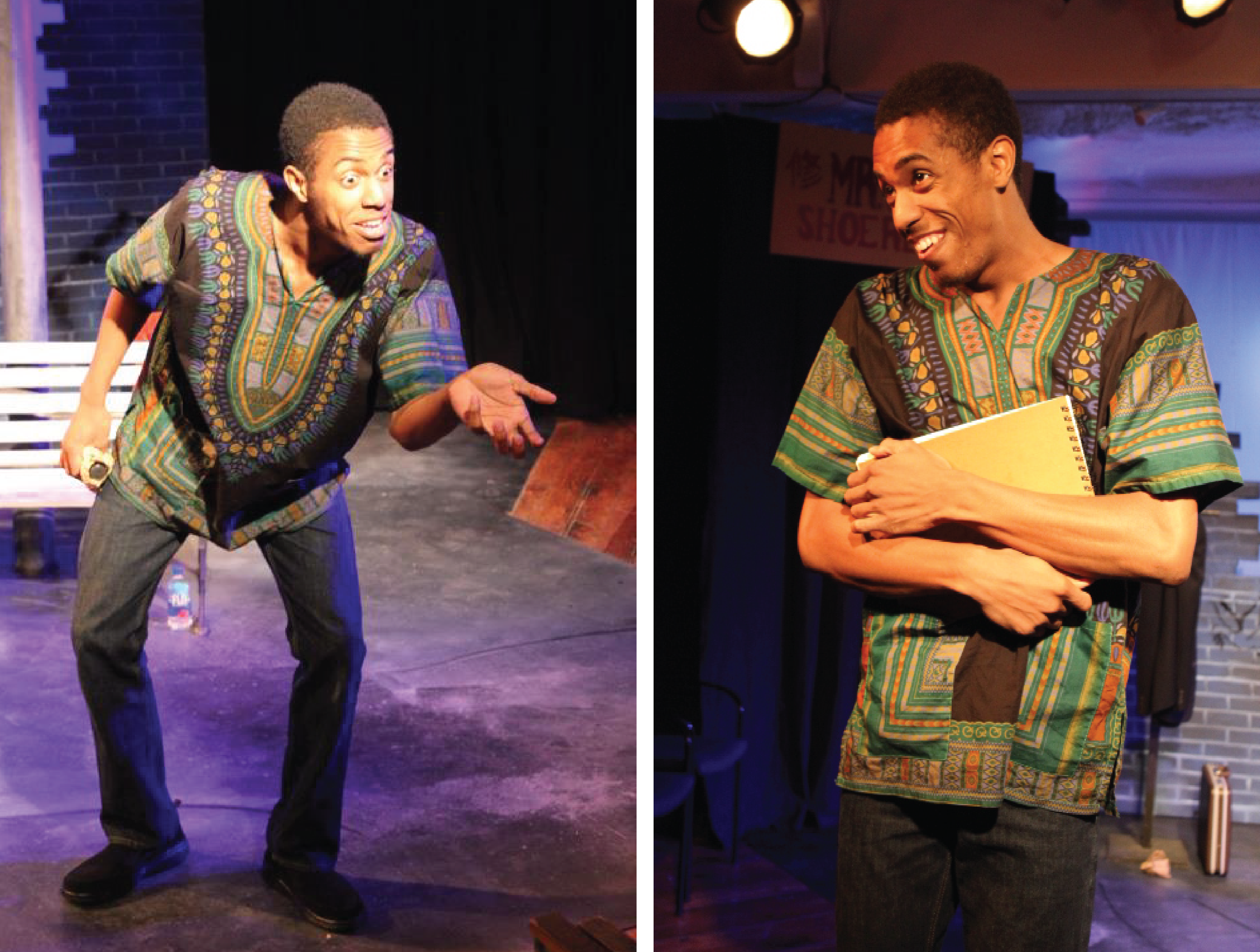
While watching Daniel Beaty’s play Mr. Joy at Theatre Nova, I immediately thought of Yong Kim, the owner of Mary’s Fabulous Chicken and Fish in Ann Arbor, who was robbed and brutally beaten with a plastic milk crate while walking to his car from the restaurant in 2014. Kim was 74 at the time of his attack, and the assailants turned out to be two teenage boys.
According to press reports, Kim managed to do something many of us would struggle mightily to do: he forgave his attackers.
Mr. Joy tells a similar story, through the prism of one actor playing several characters. In the play, longtime Harlem shoe repair shop owner Mr. Kim is robbed and beaten one night, but he won’t tell the police who his attacker was. And while Mr. Joy is the play’s nucleus, we never actually see him. Instead, we hear perspectives from those whose lives he’s touched: a homeless former painter; an 11 year old girl from the projects with AIDS, Clarissa, who considers herself his apprentice; Clarissa’s feisty grandmother; Clarissa’s schoolyard boyfriend, Peter; a young poet, DeShawn, who finds hope at church; Mr. Joy’s Ivy League-educated, real estate dealer son; the son’s rich, black Republican boss; the boss’ white girlfriend, who yearns for a child; and the boss’ transgender, flight attendant daughter, Ashes.
The hands-down best thing about Mr. Joy is seeing actor Matthew Webb embody each of the play’s characters with tremendous focus, care, and zeal. With an assist from director Billicia Hines’ guiding hand, Webb uses minimal costume changes and props – a notebook, a blazer and briefcase, a pair of red pumps, etc. – and efficient physical cues, like posture and gait, in addition to vocal inflection, to delineate the transitions between characters, and the effect is powerful. Despite the number of characters, and despite a couple of them earning a tenuous-at-best place in the narrative, Theatre Nova’s production never lacks clarity, and Webb’s performance is truly gripping to behold. (Those who previously saw the actor perform in TN’s I and Thou will leave Mr. Joy a much deeper appreciation for his talents and versatility.)
That said, Beaty’s play itself doesn’t provide much that’s bracing or new or thought-provoking regarding our ongoing national discussion of race, class, and inequality in America. Yes, there are moments of both sweetness and pain in the show; and DeShawn, in one scene, performs an impassioned performance poem that taps into the rage and fear and frustration of the community.
But we also hear familiar banalities from Grandma Bessie about faith, and how important it is to make the effort to talk to people; we see a character who will forever define himself by his own worst act – yet it’s hard to believe he even committed the crime, based on the short glimpses we’re shown of him, so the play’s “big reveal” feels instead like an unsatisfying, unearned authorial shortcut.
And finally, we have a politically conservative black man’s self-imposed estrangement from his child, born a son, because he chooses to undergo surgery to become a woman. This level of emotional complexity demands a play unto itself, frankly, in order to really dig into the issues involved; getting the drive-by version inevitably falls short.
Set designer Kelsey Nowak keeps things simple, with a busted brick wall backdrop (in front of a screen for occasional projections), a bench, milk cartons, a stool, a coat stand, a store sign, and a raised corner for Mr. Joy’s regular customers to leave shoes as a kind of prayer for his recovery. Daniel C. Walker lights the show beautifully, signaling character and mood transitions. And costume designer Carla Milarch (who also designed the show’s sound) found clothes that were neutral, but also wholly appropriate, for Webb to wear as he navigates between a broad variety of characters.
I’ll confess Theatre Nova’s design elements, paired with Webb’s powerhouse performance, had me seduced as the lights came up; but the more I thought (and wrote) about the play, the more I couldn’t overlook the script’s shortcomings. For unlike Ta-Nehisi Coates’ invigorating, harrowing, brutally honest book Between the World and Me – a letter to Coates’ son about growing up as an endangered black man in America – Mr. Joy never takes the risks necessary to push us into new, uncharted territory in regard to talking about race; and that’s precisely where we need to go if anything’s going to change.
Jenn McKee is a former staff arts reporter for The Ann Arbor News, where she primarily covered theater and film events, and also wrote general features and occasional articles on books and music.
Mr. Joy runs through October 23 at the Yellow Barn, 410 W Huron St, Ann Arbor. Visit https://www.artful.ly/theatre-nova/store/events for tickets.
No Tickets Needed: A Free Dose of Culture

Ann Arbor is a city that has plenty to offer, but sometimes the cultural highlights may be a *little* beyond the budget for those of us who may not have the most regular of paychecks. So for those of you who are looking for an arts experience while still saving $$$, look no further! This piece of blog is here to share the local arts events you can attend FOR FREE!
The University of Michigan’s School of Music, Theater, and Dance is a great source of low-or-no-cost access to displays of incredible talent. The UM-SMTD events calendar, lists concerts, lectures, and master classes taught by visiting instructors or guest faculty. This calendar has a $ symbol on events that have a cost, but thankfully those symbols are few and far between.
Earlier this month, I participated in an open-to-anyone master class led by a guest instructor in the dance program. I arrived and grabbed a seat, which turned out to be right beside the guest speaker, Anita Gonzalez. This was less awkward than it might have been because she was soon on the floor, warming up with the rest of the dancers. Gonzalez called the class to attention as the dancers stretched and flexed and effortlessly made shapes with their bodies. As she led activities, she explained the connection between breath, voice, and movement. Eventually, the dancers created moving historical vignettes of African American slaves working in the fields, with lumber, or on the railroads – singing the songs that kept them from despair and connecting them through their common goal of freedom. It was amazing to watch.
But wait, there’s more! The art of the written word is celebrated almost every day of the week at Literati Bookstore on Washington St! Just a few weeks ago I attended a (free!) reading at Literati of the new fiction bestseller The Nix by author Nathan Hill.
The Nix is Hill's first book that the Literati emcee described as “deceptively simple” but with the excitement of a “choose your own adventure story.” The major selling point for me was the claim that it was “a big book that reads fast.” Once Hill took the podium in that second floor Espresso Bar space, he explained The Nix was 10 years in the making, and once he started reading from the work, I had to agree that it was 10 years well spent. The reading he selected was from a chapter in which a student in the protagonist's logic class manages to include all 16 types of fallacy as they argue for a better grade.
The chapter is hilarious; my cheeks hurt by the end of the night from constantly smiling. Hill’s main character comes across as well-educated and flawed in relatable ways that make you want to keep reading. In this chapter, Hill also features a run-on sentence of epic proportions which required him to fortify himself with a drink water before reading it. It was truly a delight to hear this new author read, and I encourage readers to get their hands on a copy if only to discover why the words “aluminum” and “nuther” are so laughable.
Literati has tons of events, so check their calendar often to stay up to date. It is usually only their "ticketed events” that have an associated cost - most Literati events don’t cost a dime!
Liz Grapentine is a desk clerk at AADL. A graduate from Oakland University with a major in Music Education and a minor in English, Liz enjoys all the arts in every form. Liz is also a true Ann Arbor townie and a proud patron of the library since 1995.
Fabulous Fiction Firsts #615
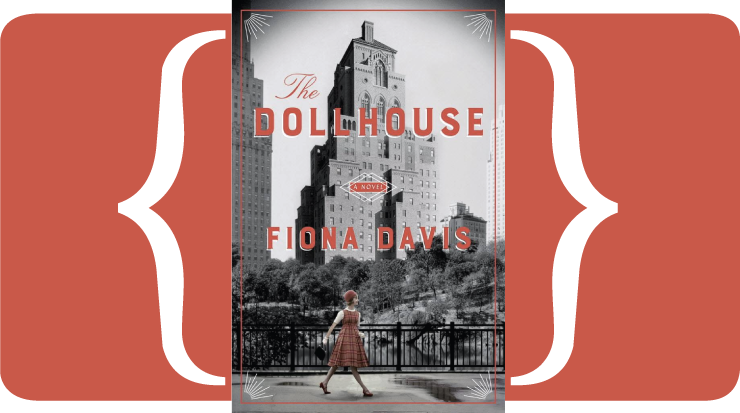
Referred to as The Dollhouse * by the Manhattanites, the Barbizon Hotel for Women is where aspiring models and secretaries who often come from small towns, try to make it on their own in the 1950s.
Darby McLaughlin arrived from Ohio to take up secretarial studies at the Katherine Gibbs School . Compared the glamors Eileen Ford housemates, she was plain, self-conscious, and homesick. Befriended by Esme, a Barbizon maid, she was introduced to an entirely new side of New York City: seedy downtown jazz clubs.
Over half-a-century later, journalist Rose Lewin is evicted from one of the Barbizon condos when her divorced boyfriend decides to reunite with his family. Rose is forced to take refuge with her reclusive downstairs neighbor Darby, one of the original tenants. As Rose's life implodes around her, she is consumed with the story behind the rumors that Darby was involved in the grisly death of Esme. Yet as Rose's obsession deepens, the ethics of her investigation become increasingly murky, and neither woman will remain unchanged when the shocking truth is finally revealed.
"Darby and Rose, in alternating chapters, weave intricate threads into twists and turns that ultimately bring them together; the result is good old-fashioned suspense," (Publishers Weekly) by debut novelist Fiona Davis.
Sylvia Plath's The Bell Jar was based upon her time working at Mademoiselle and living at the Barbizon (called The Amazon in the novel). This historical landmark, built in 1927 is now upscale condos under the name Barbzon 63.
Readalike: Searching for Grace Kelly by Michael Callahan (another FFF) and Suzanne Rindell's Three-Martini Lunch will captivate readers with a strong sense of time and place as the authors bring a legendary New York building to life and populates it with memorable characters who find themselves in unusual situations.
* = starred review
Review: Encore’s Full Monty delivers laughs and quiet emotions
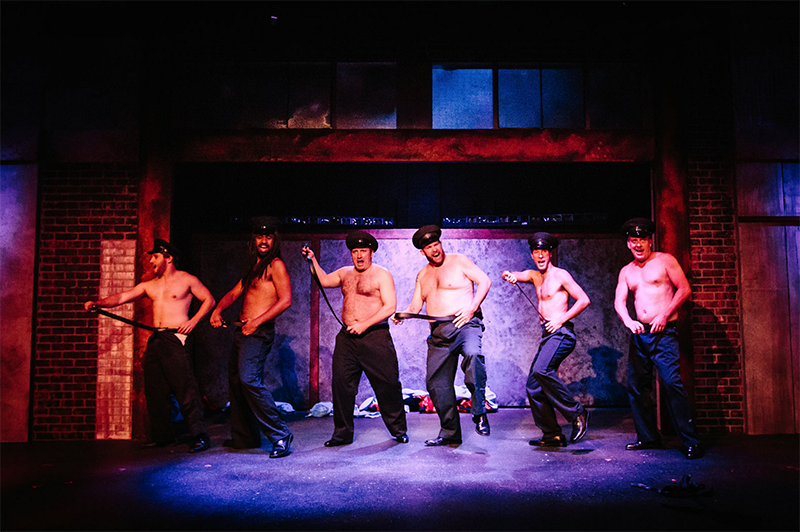
The Encore Musical Theatre Company is taking it all off and going the Full Monty for a lot of laughs and a bit of introspection.
The 1997 movie The Full Monty was part of a long tradition of British comedies with a biting social message. It was hilariously funny and a bit naughty but it was also at times a poignant and carefully observed view of a steel town, Sheffield, England, in the throes of yet another economic downturn.
In 2000 playwright Terrence McNally moved the story from England to equally downtrodden Buffalo, New York, and replaced the lively Top 40 R&B soundtrack with an original score with lyrics and music by David Yazbeck. The musical doesn’t have the grit or the deeper sense of class alienation of the movie, but it does have a nice blend of good humor, touching drama, and a bright jazzy score, which Encore brings beautifully to life.
Jerry Lukowski and Dave Bukatinsky are recently unemployed steel workers. Jerry is divorced, behind in his child support and afraid of losing contact with his middle-school-aged son. Dave is overweight, uneasy with his body and his life. After seeing the excitement created by a Chippendales-style strip show among the local women, Jerry decides that they should create their own show with dreams of making $50,000 and getting their lives back in order. Knowing their bodies would not be a lure, Jerry tells some local women that they will go the full monty, totally nude.
This production gets off to a great start by having two excellent actors in the lead roles. Eric Parker as Jerry brings energy, a bit of self-conscious swagger, and a sensitive change from macho to humane. Parker makes Jerry a full human being in search of who he really is. He isn’t a great singer but he gives real authority to tough songs like "Scrap," comic songs like "Big Ass Rock" and the gentle reflection of "Breeze Off the River," a love song to his sleeping son.
Greg Bailey’s Dave is a lumpish, dragging, sad-eyed mess as Dave. He’s good-hearted but unhappy with his body, his discomfort in what should be a happy marriage, and his loss of a job. Bailey captures just the right amount of languor and hangdog expression to make his transformation toward the end all the more triumphant.
The entire ensemble gives it their all. Dan Morrison is Harold, the laid off manager with the expensive wife. Morrison gives the character a nervous energy that goes from unease to “what the heck” let’s do it charm. Matthew Pecek is the mama’s boy Malcolm and he first appears as a suicidal mess, his thin body tightly wrapped, and then he opens up as he finds himself and love. Pecek, also, has a fine singing voice.
Jordan Harris plays Horse, a black man with the dance skills. Harris brings some extra zip to the dance numbers and some sly comedy when dealing with a certain black stereotype. The last member of the dance group is Ethan, a man obsessed with Donald O’Connor’s ability to climb walls and possessing a special asset for a stripper. Brendan Kelly is funny and also brings a good singing voice to his duet with Pecek.
Gayle Martin is Jeanette, the tough talking piano accompanist who has seen it all and played for the best of them (or so she says). Martin has some great lines, which she delivers with deadpan perfection.
A wilder bit of comedy is served up by the rubber-faced Sarah Briggs who plays Harold’s money loving wife. Briggs is a gifted comic actress who lights up the stage on "Life With Harold," a rollicking affirmation of love, and lets it all out in a later scene where her love shines through.
Alejandro Cantu has the difficult role of Nathan, Jerry’s long-suffering son. He loves his dad and his mom and he kind of likes his mom’s nerdy boyfriend. Cantu is a young actor who understands these conflicting emotions and just what they can do to you. His performance is direct, sensitive, and never “cute.”
In the small role of Keno, a studly Chippendales dancer, Colby Orton proves charming and captures the dancer’s sincere good intentions.
Thalia V. Schramm, who co-directed with Matthew Brennan, does double duty as Dave’s concerned wife, and provides the right amount of warmth when things get low.
Schramm and Brennan keep the comedy within the range of reality enough to make the serious moments have resonance. This is a comedy with serious content, from body image to economic justice to the plight of divorced fathers, and it plays them with some degree of respect.
Brennan is also the choreographer and he has the chore of directing some deliberately bad choreography in the beginning and then a triumphant Act One closer on "Michael Jordan’s Ball," a dance inspired by the great Bulls forward.
The small ensemble under musical director R. Mackenzie Lewis gives fine support from their perch. Yazbek’s score is serviceable, with some jazzy moments and a lively "Let it Go" ensemble number at the giddy and satisfying ending.
This is not a show for everyone. It has some rough language and bared backsides. But the end result is not raunchy and the music and story are upbeat.
Hugh Gallagher has written theater and film reviews over a 40-year newspaper career and was most recently managing editor of the Observer & Eccentric Newspapers in suburban Detroit.
The Full Monty continues at the Encore Musical Theatre, 3126 Broad Street in Dexter through Oct. 22. For times and ticket information, call the Encore Theatre Box Office at (734) 268-6200 or visit http://www.theencoretheatre.org.
Review: The TEAM's "RoosevElvis," presented by UMS
One unforgiving truth of fame is that when you become larger-than-life, you’re also conversely diminished, so as to seem elusively inhuman.
Brooklyn-based The TEAM’s experimental theater production RoosevElvis, now playing in Ann Arbor by way of University Musical Society, begins with a scene that illustrates this very point. Theodore Roosevelt (Kristen Sieh) and Elvis Presley (Libby King) sit next to one another in director’s chairs, sharing a microphone between them as they take turns voicing odd autobiographical facts and anecdotes.
Significantly, the back-and-forth doesn’t feel like two competitors trying to one-up each other – yes, Roosevelt stridently brags, but Elvis isn’t intimidated, blithely contributing his more modest memories with a laid back slouch. In this way, the exchange illustrates key differences between the two icons of American masculinity.
Sieh, decked out in Roosevelt’s trademark facial hair and glasses, as well as a fringed cowhide suit (Sieh designed the shows costumes as well), employs a sharp patrician delivery that echoes Katherine Hepburn. We hear about Harvard, and how he won an election at age 23. “What a great story,” she says often, congratulating herself.
King, as Elvis, wears blue suede shoes (of course), jeans, a white T-shirt, and a red, short-sleeved button down shirt, topped with a modest Elvis wig, of course. Far more retiring and relaxed than Roosevelt, Elvis talks about being an only child, moving to Memphis, and hearing his first record played nine times in a row on the radio.
But after this introduction, the green screen behind them disappears to reveal the drab apartment of Ann (King), a shy, lonely, 35 year old meat-packing plant employee in Rapid City, South Dakota. (During the transition, you see video footage of her at her workplace.) As Ann, King enters the apartment with a 6 pack, drinks a beer, and engages in a one-person conversation between herself and her idol, Elvis, about having, for the first time, connected with a woman via the Internet. Soon Brenda (Sieh), as a self-assured taxidermist who’s in town for a conference, emerges wrapped in an Elvis towel from the bathroom.
So yes, it takes a few minutes to get your bearings while watching RoosevElvis – and, fair warning, you likely never will completely. But that’s the aim of experimental work, of course. You have to let go of the desire/expectation for linearity and absorb all the ideas and trippy images that are playing out in front of you on stage.
Even so, there is at least a loose narrative at the center of RoosevElvis: Ann’s hopeful, extended date with Brenda – a Roosevelt fan, not coincidentally – turns sour as the two women take a road trip to the Badlands, including stops at Mt. Rushmore and Wall Drug. Though the show relies a bit too heavily on Andrew Schneider’s backdrop videos, the clips are often used in interesting ways. For instance, when Ann recoils from Brenda’s sexual candor in a diner, two video screens show the two women eating their meal in silence, thus underscoring the fact that what began as a hopeful adventure into love has ended in an uncomfortable, miserable stalemate.
Roosevelt and Elvis appear to have earned a place in Ann’s psyche because they embody ideals of masculinity, and as a woman who wears men’s Y-front briefs, and feels like “one of the guys” among the men working at her side at the meat packing plant, Ann is working through who she is, and whom she wants to be. Plus, her rough break-up with forthright, Roosevelt-like Brenda, who calls her “un-brave,” rattles her enough to drive her to take a solo trip to Graceland. Along the way, she leaves Roosevelt and Elvis behind in a hotel room, which they know bodes well for Ann; but when left with just each other, they clash and criticize each other, exiting with the classic line, “Let’s take this outside.”
There are many other delightful, strange, surprising moments in RoosevElvis, wittily directed by Rachel Chavkin: Sieh’s Roosevelt ballet, in which a gentle, beautiful grace is combined with showy muscle-flexing; a sudden, one-off Ann-Margaret moment; Roosevelt pulling on boxing gloves and calling for a TEAM member to start the footage from “Planet Earth,” so that he may punch at the bison individually on-screen (hysterical); Sieh’s funny, uncanny portrayal of a Spirit Airlines representative, urging Ann to stay on hold; the thoughtful use of rowing machines as a set piece (the set was designed by Nick Vaughan); and a Thelma & Louise tie-in that’s far more than a pop culture wink.
But King is the show’s emotional core, and she delivers a dignity, a humility, and a hunger that’s palpable, both in Elvis and Ann. That’s not to say that every part of the show hits its mark. With a running time of just over 90 minutes, the show feels oddly labored after a while, particularly following Brenda and Ann’s final, bracing phone conversation. And there’s a brief scene in which King and Sieh transform into diner waitresses for just a moment – and I still don’t know what purpose that served.
That’s OK, though. When an innovative theatrical company like The TEAM goes on an adventure and asks you to come along, I think it’s mostly worth the bumps in the road to experience the ride.
Jenn McKee is a former staff arts reporter for The Ann Arbor News, where she primarily covered theater and film events, and also wrote general features and occasional articles on books and music.
RoosevElvis runs through Saturday, October 1, at the Lydia Mendelssohn Theatre, 911 N. University Ave. Visit http://ums.org/performance/roosevelvis/ for more information and tickets, or call 734-764-2538.


